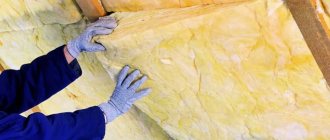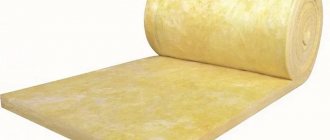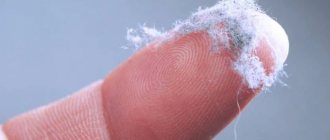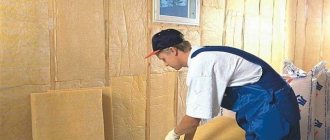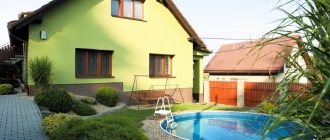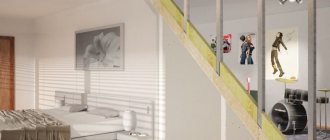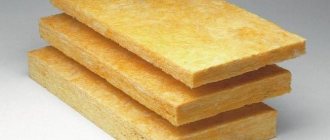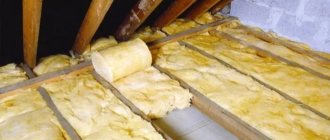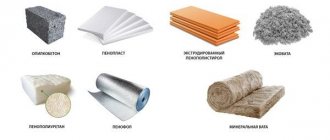If a mink is a noble rodent, then a mouse and a rat are unlikely to be so. Of course, there are decorative home varieties. But now it’s not about them. Rodents can ruin all your efforts to insulate your home. Therefore, you need to know whether mice breed in mineral wool, as well as in other thermal insulation materials.
When performing insulation, everyone tries to make the correct calculation, leave ventilation gaps, remove unwanted cracks, think about the likelihood of cold bridges, and also avoid shifting the dew point inside the walls.
But all these efforts become in vain when mice, as well as their larger counterparts, rats, begin to chew through the insulating material.
It’s hardly worth talking about whether mice live in sawdust. This is a natural material, and even food for them. So yes.
But what about other materials? What mice don’t gnaw, where they definitely don’t breed, and in what cases the likelihood of meeting such neighbors is highest. Let's figure it out. While you're reading, you can also grab something to chew on. Unless, of course, photos of rodents displace you.
Do they live
There are several insulation materials that pests can easily chew through. One of the most unstable materials is polystyrene foam. The main advantages of foam plastic in construction: lightness, ease of installation and accessibility.
Rodents do not eat the material itself, but easily gnaw through it, making holes and passages . Animals will easily live and reproduce in voids. Rats can use the insulation to make their nests, grinding it into dust.
To prevent the destruction of polystyrene foam, use a fine metal mesh or treat it with boric acid or copper sulfate.
Porous materials, such as expanded polystyrene foam, are more resistant to pests. Rodents can damage it, but they will not be able to live in the insulation. Expanded polystyrene is also resistant to moisture and mechanical damage.
In glass wool
Glass wool is one of the varieties of mineral wool. Its main characteristics are fire resistance, frost resistance, elasticity and lack of sensitivity to chemicals. This kind of insulation does not allow fungi to grow and it allows air to pass through well. Glass wool is made from waste from the glass industry.
Mice in glass wool can make moves due to the low density of the material. They will not feed on the material itself, as it is of no interest to them. However, pests easily settle in the type of insulation in question. The attention of mice is especially attracted by the additional use of natural insulation materials - reeds, sawdust, clay or straw.
In mineral wool
Mice also willingly settle in mineral wool. Rodents can handle any type of mineral wool, be it glass wool or stone wool. Animals skillfully crush the insulation and make their nests in it.
In this case, it will be difficult to get rid of the problem due to the impossibility of using poisons and chemicals. A poisoned rodent can die in the insulation, causing a putrid odor in the house.
Important fact! Any type of mineral wool used as home insulation must be reinforced with rigid and bulk materials.
In basalt wool
Basalt wool has high strength levels. It has replaced traumatic glass wool, which is used less and less in construction.
Basalt wool ranks first in the total volume of sales of thermal insulation materials. The insulation consists of thin fibers obtained by rapid melting.
Rocks are also used in the production of basalt wool. Due to this, it is possible to achieve high quality and long service life of the insulation.
Basalt wool does not belong to the category of solid building materials, and rodents can easily make their passages in it. Once mice chew through walls, they can get to wiring and pipes. The later holes made by rodents are discovered, the higher the risk of serious consequences.
Rodents do not like nesting in basalt wool: the fibers of the material are prickly, which is not to the taste of small pests. The product is also resistant to putrefactive processes, mold and insects.
In stone wool
Stone wool is widely used for insulating attics and vertical structures intended for long-term use. Stone wool is considered an environmentally friendly material and can be used without fear in home construction.
Mice build their nests in stone wool, although they do not feed on it . Rodents spoil the material, which negatively affects the results of construction, so it is better for the homeowner to find other materials to insulate the home.
In expanded clay
Expanded clay is used to cover floors and foundations. It absorbs noise well and is considered a relatively cheap building material. Rats and mice are not able to chew through it due to its strength and inedibility. Animals also do not make burrows in expanded clay and do not build nests.
Despite its high performance characteristics, expanded clay has significant disadvantages : low environmental friendliness and complexity of installation. When heated, it begins to release toxic substances, so formwork must be erected before using the material.
If there are rodents
It happens that rodents appear even in mineral wool; if they appear, then strict steps must be taken to combat them. Options:
- Get a cat. The method is as old as the world, but still works flawlessly.
- Inside the house, you should use repellers that produce a sound of a certain frequency. It repels rodents from the house. When selecting such a device, you need to make sure that it only affects rodents, and not cats and dogs.
- You can sprinkle the perimeter of the house with broken glass or sawdust, which is treated with lime, copper sulfate, and borax.
- The thermal insulation material should be painted after installation; mice do not like varnish and paint compositions very much.
- Use a special poison for mice, preferably with a mummifying effect. Even if a rodent crawls into a hole, it will not emit an odor after eating the bait.
What kind of insulation do they not live in?
There are enough types of insulation in which mice do not live in the construction market. Their characteristic properties are high strength and density, low environmental friendliness.
However, there are also new innovative insulation materials that are not exposed to rodents and at the same time are absolutely safe for humans from an environmental point of view. Let's take a closer look at which insulation does not breed mice.
Ecowool
The relatively new material is not damaged by rodents, despite its softness. Ecowool is treated with orthoboric acid, which repels pests. The acid also acts as an antiseptic. Therefore, ecowool is resistant to fungi and insects.
The insulation is absolutely safe for humans, so it can easily be used for thermal insulation of floors and ceilings. The main disadvantages of ecowool: high level of flammability and high cost.
Velit
Velit does not attract rats and mice due to its porous structure. The material is not dense, but absorbs noise well and has high heat retention rates. No toxic substances are used in the production of insulation, so it is used in construction without fear.
Velit is one of the most popular insulation materials due to its low cost. It was developed in Russia and is fully adapted to the climatic conditions of this country.
Foam glass
Foam glass is inaccessible to rodents due to its high strength.
There are several advantages of the material when insulating houses::
- absence of harmful fumes;
- ease of installation;
- resistance to rodents, even rats);
- durability.
Foam concrete
Another material that is not afraid of rats and mice is foam concrete. It differs from traditional concrete in being lightweight due to its porous structure. The only drawback of the material is its instability to moisture and fungal attack.
Let's sum it up
See also
Brick-like facade panels for exterior decoration of the house
There are insulation materials that a mouse or rat can easily chew through. And even eat with great pleasure.
There are materials that rodents do not feed on, but they still build their own burrows. And this is also a bad situation.
At the same time, they highlight a list of products where unwanted neighbors will not want to settle. They are afraid of the smell and don’t like the taste. No one will live nearby. Therefore, you won’t have to worry about uninvited guests.
Of course, you can also use insulators that are attractive to rodents. But at the same time, provide reliable protection against their appearance in the walls and under the roof. It’s just better to predict all this in advance, even at the stage of construction or insulation, if this is an old house being renovated.
Are there mice or rats in your house? What insulation attracted them? How do you solve the problem of settlers? Did you manage to get rid of them? What helped in the end?
We look forward to your answers, as well as stories from personal experience.
Rockwool and the mice
Rockwool is not attractive to mice due to its mineral fiber content. The insulation contains a small percentage of organic substances and molten basalt stones. Rats and mice do not eat Rockwool.
However, homeowners occasionally post photos that clearly show damage left by rodents on the insulation.
The list of reasons for damage to the heat insulator by mice and rats includes:
- Incorrect installation of material. Left cracks and gaps in the decorative layer of plaster. may cause animals to make passages.
- Failure to comply with thermal insulation rules. Problems arise when laying new insulation over old organic insulation, which attracts the attention of rats and mice.
Mammals can safely coexist with Rockwool, since it does not contain toxic compounds and is absolutely safe from an environmental point of view. However, they will not eat it.
Important information! You cannot treat building materials with rodent poisons yourself. Such actions can lead to unforeseen consequences and health problems for household members.
Ways to fight ants
If pests have already settled in the insulation, then the best way to get rid of them is to dismantle the infected slabs and treat the untouched material with insecticidal agents. The ideal option is to invite specialists, but their services will cost a significant amount. Therefore, it is worth adopting the most effective folk and industrial methods of fighting ants.
Folk remedies
In this case, you will have to be patient, although not for long: you cannot count on an instant effect. In addition, traditional methods are best used in combination to achieve real results. Let's look at the most popular means.
Boric acid
The composition corrodes the chitinous cover, causing paralysis and death of the pest. In addition to boric acid, you will need a hard-boiled egg - yolk, as well as any sweet ingredient: pure sugar, syrup, honey, etc.
When working with any acids, you must use protection: chemical gloves with a respirator. Otherwise, there is a risk of skin irritation and allergic reactions.
Bait recipe:
- Grind the egg yolk with the sweet ingredient.
- Add about 20 g of boric acid to the resulting mass.
- Roll the balls and place them in places where ants gather.
There is no need to rub the foam with bait or try to lay it as close as possible to the insulation. The foragers themselves will transfer the poison to the anthill, where other individuals will taste it.
Yeast
Another time-tested recipe. Classic nutritional yeast is suitable for preparing the mixture. You can use syrup or honey as an additional ingredient. Take 4-5 tablespoons of sweets and mix with 1 spoon of yeast until a homogeneous mass is formed.
Just as in the case of boric acid, there is no need to treat the insulation itself: we spread the mixture to hot spots, and the ants themselves will spread the poison. If the yeast enters the body, after some time it will simply tear the pest apart.
Industrial products
In difficult cases, it is better to look towards serious chemistry. Although it is more expensive, it is much more effective than traditional methods. In addition, the result will not take long to arrive. Aggressive chemistry begins to act within the first hours after application. On sale you can find drugs made in different formats: gels, powders or traps.
It is more practical to use industrial products at the time of installation of insulation. Chemicals with a pronounced prolonged effect will not leave pests a chance.
Gels
Judging by the responses of consumers, the most effective drugs can be called “Absolute” and “Great Warrior”. They also give good reviews about the Clean House gels. It is enough to treat the slab with the product and mount it in place.
The poison contained in the composition does not act immediately. Upon returning to the colony, foragers infect other individuals. You can also use gels after the fact: apply them to baseboards, doorways and other trouble spots.
Powders
“Muravi” and “Karbofos” are quite suitable for processing penoplex. Delicia powder also showed good effectiveness. Before use, they must be diluted with water according to the instructions indicated on the product packaging. Then apply it to insulating boards.
In all these preparations, the active substance is a dangerous insecticide - chlorpyrifors. It causes paralysis of the pest and its subsequent death.
Lures
This format is used only after the appearance of ants, when the colony has begun to grow. The active substances included in the baits have a long-lasting effect. After contact with the poison, the pest spreads it throughout the colony. They must be placed with an eye on the foragers' paths.
Among other baits, consumers respond especially warmly to “Combat”, “Absolute” and “Great Warrior”. A clear advantage of insecticides of this format is that you set it and forget it. Lures do not need to be updated as often as gels or powders.
Do they chew roofing felt?
Another material that is too tough for pests is roofing felt. Its resistance to rodents is evidenced by numerous reviews from builders and household owners.
Instead of roofing felt, you can also use roofing felt, which has a specific smell that repels mice and rats. The only drawback of roofing felt is the absorption of foreign odors. However, this problem can be eliminated by installing a reliable film inside the insulation.
Thermal insulators with a strong structure - foam concrete, expanded clay or roofing felt - are resistant to the effects of rodents. Mice cannot settle inside materials and enter a person’s home.
Heat insulators containing mineral fibers: mineral, stone and basalt wool are considered relatively safe for insulating houses. Mice and rats will not consume mineral fibers as food, but if desired, they can damage them and make passages and holes in the material.
For thermal insulation at home, it is not recommended to use organic insulation and low-density materials: reeds, sawdust, polystyrene foam. They will not protect your home from rodent infestation.
Expert opinion
When choosing materials for insulating your home, you need to take into account several tips from professionals. An important aspect of choosing insulation is its cost. But we must not forget about the quality of thermal insulation. The most inexpensive of the possible options is expanded clay. But it cannot always be used as an insulation material.
If the house is wooden and is being reconstructed, it is irrational to use expanded clay. It makes the structure too heavy, so the foundation and other supporting structures may not be able to withstand the additional load. To carry out repair work in a wooden house, lightweight materials are used.
If you plan to build a new house, expanded clay will be a good option for insulating the ceiling and floor. But in this case, even at the design stage, the weight of the structures is taken into account.
Foam concrete will be a good option for insulating the walls of a brick house. It will become another wall in the building. Therefore, in order not to reduce the area of living space, you need to mount it from the outside. Foam concrete is plastered with high quality. This material is used as thermal insulation even in a wooden house. Porous blocks weigh little, so they do not increase the load on the foundation.
Foam concrete will accumulate heat, preventing the house from cooling down during the cold period. To do this, it is better to install a layer of insulation indoors. In this case, the material will perform its functions better. But the living space will be somewhat reduced.
Why choose mineral wool?
When purchasing this or that insulation, it is always important how and in what form it is produced. For example, cotton wool manufacturers have taken care of convenience. On the building materials market you can buy it in this format:
- roll;
- mat;
- cylinder;
- placer;
- plate.
Mineral wool in rolls
The material in the form of a roll is convenient in that by using it you can obtain an even thermal insulation layer in which there will be no cold bridges. The option with slabs is ideal for vertical insulation. Firstly, it does not slip, and secondly, it is quite difficult to deform it during use.
Manufacturers strongly recommend using blown-in cotton wool to fill the most difficult-to-reach cavities. Today the choice is quite large and, if you need any specific parameters of density or thickness, you can easily find a suitable option on the goods market.
Material advantages
Another positive aspect of mineral wool is its non-flammability. This material can withstand heating up to 1000 degrees above zero without changing its physical properties. In this case, it is used, of course, as a fire protection element. In the event of a fire, it will be quite difficult to contain the thickness of the insulation, but toxic components will not be released.
Interesting! Vata is safe. Mineral wool is used to insulate rooms from the inside. Today, production has been quite modified, this has made it possible to reduce the content of phenol-containing components by an order of magnitude. Mineral wool is almost the only material that is recommended for insulating wooden buildings.
This is due to the fact that a breathable layer is created that reliably protects the wall from rotting.
Mineral wool is a reliable insulation material
The material is durable. If you operate it correctly, then for 65-70 years you will not raise the issue of replacement. In slabs, cotton wool can hold its shape perfectly. This is achieved due to the fact that it is unable to:
- deform;
- crumple
- dry out.
In matters of installation, it is also quite practical. It shrinks to the required dimensions during transportation and at the same time restores its shape within ten minutes. The material is cut with a standard knife. Now let's talk about what materials rodents appear in and how to deal with them.
List of disadvantages: how to overcome rodents?
Today, only one obvious negative point is known when choosing mineral wool. This is because cotton wool is hygroscopic.
When a material absorbs moisture, its thermal insulation properties are significantly reduced. When humidified by 2-3%, the thermal insulation characteristics immediately change by 10-11%. That’s why installation and vapor barrier are so important.
Dusting also cannot be called a plus, but cotton wool is very rarely used for open structures. Therefore, this is rather not a minus, but simply a feature.
Mineral wool
It is impossible to say unequivocally whether mice eat mineral wool. According to the latest numerous experiments and experiments, all varieties of mineral wool are not an obstacle to rodents. Even such a prickly and irritating material as glass wool is no problem for them. Among other things, mice are as comfortable as possible in almost any insulation. They make warm nests and live comfortably.
They are primarily attracted by the following characteristics:
- does not rot;
- almost never spoils;
- high ventilation characteristics;
- always dry;
- warm;
- excellent shape maintenance.
Although if we consider such an innovative material as ecowool, then there are no rodents there. Everything is quite simple. Ecowool contains orthoboric acid, which causes severe thirst and discomfort in animals. If a rodent decides to make a nest, it won’t last long; it will have to move soon.
Reviews
Last fall (2015) I insulated the utility room with 50 mm polystyrene foam. Everything was great in winter. With the onset of spring, mice came and gnawed the wall (foam). To be honest, they don’t bother me much in themselves, but I need it to be warm in winter. The insulation needs to be changed, please tell me what materials rodents do not touch?
I left a roll of insulation in the utility room for the winter. After the season I noticed a nest, I think it was a weasel that spent the winter in a roll. I don’t know about mice, but for rats! Even Soviet glass wool is not a problem to build holes for yourself. We need to add poison. I cover it from above so that the birds do not touch the grains. If necessary, I can add more in winter.
A fact is a fact, and there is no arguing about it. It is clear that measures need to be taken not yet at the construction stage. Attention question: which ones exactly?
Study
The answer to the question about thermal insulators that repel rodents is impossible without market research. In total, it contains two types of heat insulators - organic and artificial.
Organic insulators are made from recycled or natural materials. They contain a minimum of chemical additives - only substances that resist fire. The main examples are ecowool, reed, straw, etc.
There are many more inorganic or artificial heat insulators. And if natural ones are produced, as a rule, in bulk or in slabs, then this category has more formats: slab mineral or basalt wool and loose perlite. You can opt for solid aerated concrete. Next we will talk about reliability indicators in relation to rodents.
Unsustainable materials
All these materials are artificial and inedible, but this does not stop mice from gnawing them, turning them into dust, and building nests in the empty voids.
- Basalt wool, glass wool and other mineral wools.
- Any foam plastic (expanded polystyrene, foamed and extruded).
- Fibreboard, chipboard, MDF boards.
The main criterion by which pests choose housing for themselves is that the material must be low density, warm and dry. For example, polystyrene foam - they especially liked it.
There is an opinion that animals avoid penoizol, polyurethane foam and extruded polystyrene foam, this is not entirely true. They are denser than ordinary polystyrene foam, so mice will not settle in them, but they still chew and damage them very well. Only foam balls in concrete are too tough for pests.
conclusions
So, at the beginning of the article we were faced with three tasks: to find out how to insulate the house so that mice and other rodents could not grow in the insulation, how to process the material so that it would not be interesting to them, and how to remove pests if they are already visiting. We noted that:
- Mineral wool and polystyrene foam are attacked;
- A fencing structure needs to be built around the insulated area - for example, polystyrene foam can be plastered without leaving even a small gap;
- Material treated with insecticides or orthoboric acid repels pests;
No matter what the material is treated with, mice will definitely not appear in the insulation only if it is covered with a protective layer. The material thus protected will properly serve its intended purpose.
Sources
- https://6sotok-dom.com/materialy/gryzut-li-myshi-penopleks.html
- https://TeploRes.ru/montazh-i-remont/gryzut-li-myshi-penopleks-2.html
- https://apest.ru/myshi/vse-o-myshah/gryzut-li-myshi-penoplex/
- https://EnergoSpravka.ru/montazh-sistem/gryzut-li-myshi-penopleks-2.html
- https://felisov.ru/tarakany/edyat-li-myshi-penopleks.html
- https://uteplix.com/materialy/edyat-li-myshi-minvatu-penopleks-penoplast-i-drugie-utepliteli.html
Effective methods
Rodent control
- Mouse repellent herbs are laid out in the holes around the perimeter of the rooms: peppermint, chamomile, lemon balm, tansy, wormwood. If the premises are non-residential - elderberry leaves, walnut leaves, black root seeds, burdock seeds.
- Wood ash is sprinkled along the walls. This component causes irritation to the skin of the paws, and the animal feels discomfort. He tries to lick the ash, it gets into the stomach, causing abdominal pain. The condition is not fatal, but with constant discomfort it forces the rodent to run away.
- The floor is washed with the addition of vinegar and ammonia every evening. You can leave the concentrated substance in a saucer in the corners of the room. Or they use essential oils to repel - mint, chamomile, citrus, lavender.
- Make your own traps from plastic bottles. The neck is cut off, mouse bait is placed inside the bottle, and the walls are lubricated with vegetable oil. Insert the cut neck back in the form of a watering can and secure with tape. They leave it in the room.
- The modern trap is a glue trap. Sold in tube. Glue for mice is applied to a plastic base, drywall, plywood, and fixed to the floor so that the mouse does not drag the trap along with it. Bait is placed in the center. The rodent initially sticks with its paw, then with its whole body. Several pests are caught in the trap at once, but it is better to use it in non-residential premises.
- The ultrasonic repeller is an innovative product against mice. But the effectiveness is reduced by walls, carpets, and furniture. It is recommended to install several at different ends of the room. You should buy a device with proven effectiveness, as indicated by consumer reviews. You can use the Typhoon, Clean House device. In Moscow they buy in specialized stores.
Mousetraps, traps, traps should be placed near holes, near walls. Mice always move along the learned route. If there are few pests, you can deal with them in a few days.
If mice appear under the skin of a house, this negates all the builders’ efforts to insulate it.
Rodents make nests in the insulation, make passages in it, cold penetrates into the resulting holes, and heating costs increase.
In order not to suffer from this disaster, and not to have to make expensive repairs, it is important to immediately know which insulation is not chewed by mice and rats.
